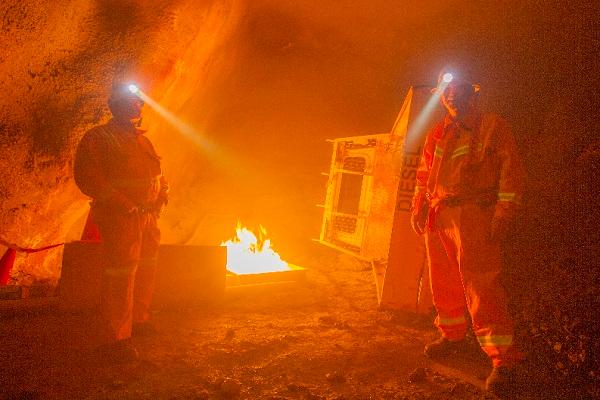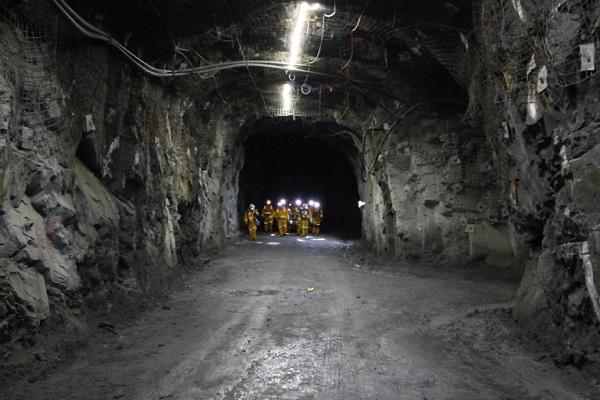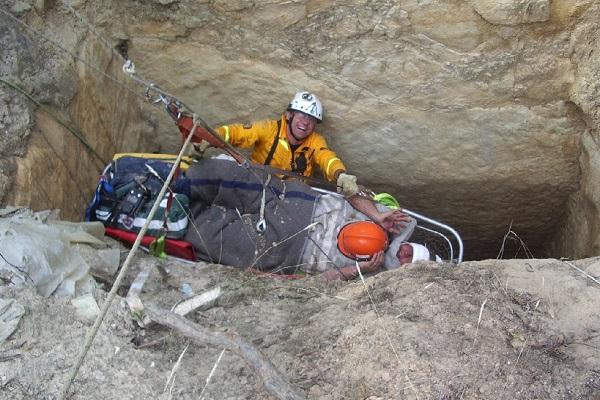Carrying out rescues in pitch black, battling different conditions on each call-out, and making sure all members come home safely are some of the similarities between Oscar 1 and a typical brigade.

The difference is Oscar 1 usually completes rescues underground, sometimes hundreds of metres under the earth’s surface.
Based in Bendigo, this team of volunteers are skilled in using long duration breathing apparatus, level 3 first-aid, gas detection, underground search and rescue, vertical rescue, and confined space rescue.
A unique skillset is required of the team’s members but as Captain David Priest explained, group cohesion is key.
“Our guys are going down into the ground with 30 to 40kg of gear on them at once, so you do have to be physically able. But more than that, it’s knowing how your team works,” David said.
“Our people know each other really well. We’ve all got to know each other’s capabilities, and as a consequence we’re interchangeable when it comes to a job. Usually we have teams of six. You might be a rigger, a medic, a gas detector, doing grunt work, and then a captain and a vice-captain. I have no problems giving those roles to different individuals.
“You really have to trust the people you’re working with in the underground environment … and we do.”
Common responses for the team include underground fires and vehicle accidents in commercial mines, rescuing people and dogs, and assisting police with knowledge, investigations and rescues. They also support other brigades.
While these are regular incidents, David noted he had also received some more unusual calls in his 20 years as leader of the team: a request to release a trapped wedge-tailed eagle; cattle that had fallen into mine shafts; a motorbike that had fallen down a shaft; and assisting a woman who tried to retrieve a rare type of fern from inside a mine.
Although the group receives a low number of call-outs each year compared with other brigades, it plays a vital role as the only volunteer mine rescue team in Australia. Active since 1999, it’s also the only CFA brigade with underground mine rescue capability.
Group Training Coordinator Alun Hughson, a former operations officer in North West Region, believes Oscar 1 will become even more important because of urban sprawl.
“When we talk about why Oscar 1 exists, the basic reason was so we could manage all the disused mines around Victoria. There are thousands of them and they’re all different sizes,” Alun said.
“As towns become more spread out, areas that used to be bushland become recreation areas. There could be more and more people going through the bush who don’t quite have the knowledge of the area or the unexpected dangers that people had in the past.”

Sometimes though, as Alun reflected, even those with local knowledge of an area can get into trouble.
“We had a rescue at Chewton [near Castlemaine]. The gentleman knew the area very well and he decided to take his friends to look around. He tripped on a rock and fell 30 metres down a mine shaft.
“Brigade member Kylie went down and performed first-aid while hanging on a rope 35 metres down into the mine. His leg was in a bad way - it was a precarious situation.
“We have wrap-around stretchers for tight spaces, so we used that. We raised him a further four or five metres into another side drive, and brought him back up that way because it was slightly easier.
“Coincidentally, only months earlier a dog fell down the same shaft, so we were familiar with the mine.”
One of the group’s first rescues, which turned into a double rescue, could have been a lot worse.
“In Rushworth on New Year’s Day in 2005 we had a bloke about 15 metres down, stuck on what’s called a bird’s nest - an area with a light covering of debris inside a mine. Another emergency services worker insisted on going down, but unfortunately he fell through the bird’s nest. Luckily, we made him keep his safety line on. We had to haul him out first before we could get the casualty out.
“Later on at a debrief, DELWP maps showed that that particular mine was actually 120 metres deep.”
The group actively trains and takes part every year in the Victorian Mine Rescue Competition. Last October they won the Rope Rescue Challenge at the competition; the only non-industry team and the only volunteer team participating.
“The rescue teams from all over Australia are our peers. Oscar 1 is accepted by them and can integrate easily at any major mine or urban search and rescue incident because they train and learn from each other and the equipment is the same.”
There are 22 members in the group, which seems a small number considering the size of Victoria. David said the key ingredient to the group’s success is getting the right members rather than a lot of members.
It’s important to note that all members of Oscar 1 are also members of other brigades - something that benefits those brigades, according to David.
“I think people might choose to join us because we’re a bit different,” he said.
“We offer the chance for a different skillset, learning rope skills, mine knowledge, which rocks are safe and which aren’t, all that sort of stuff.
“They might choose us because they’re interested, but more than that they just want to help. Their brigades don’t lose a member when they join us; they actually get someone back with a great set of skills that they didn’t previously have.”

Author: CFA News & Media